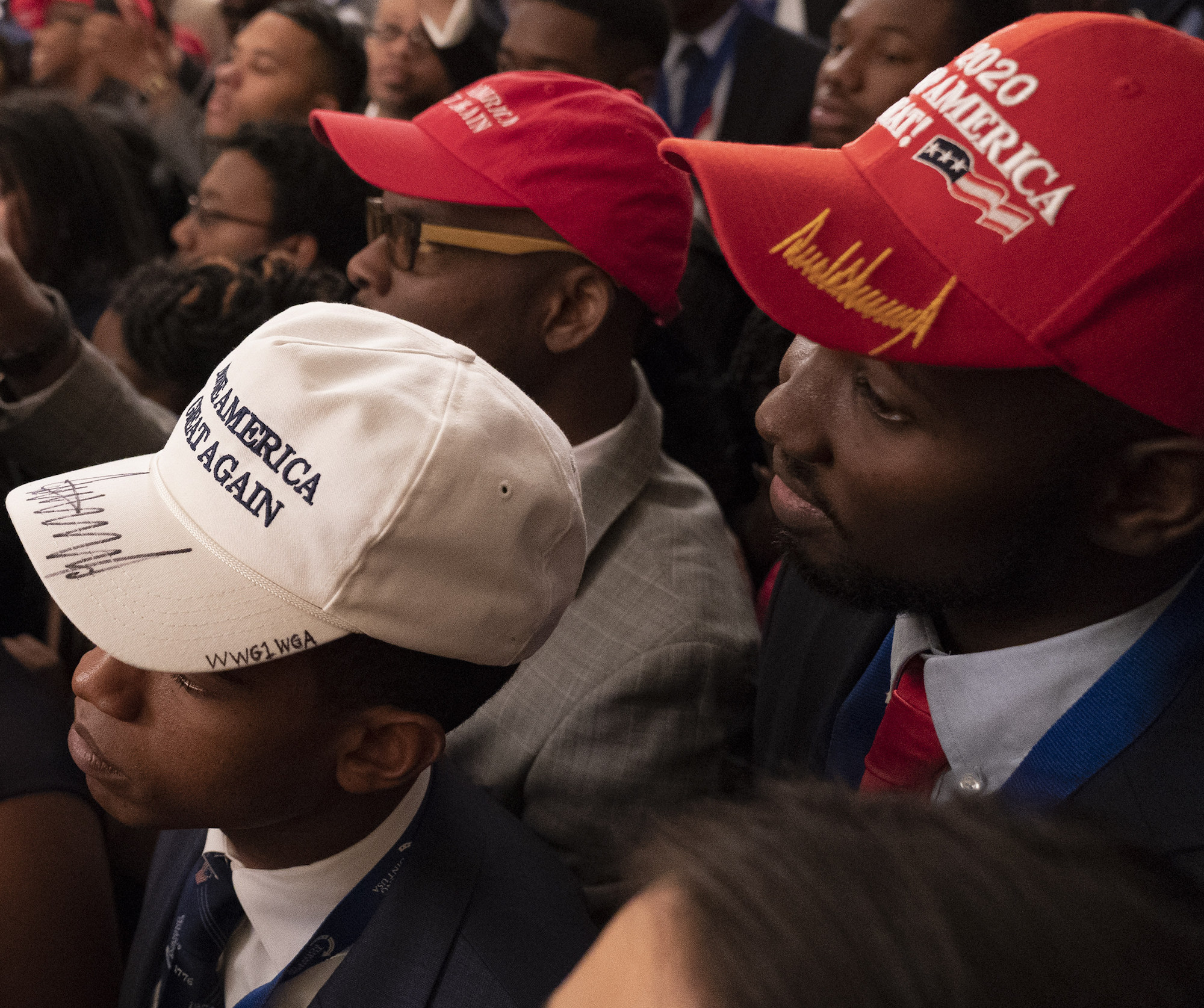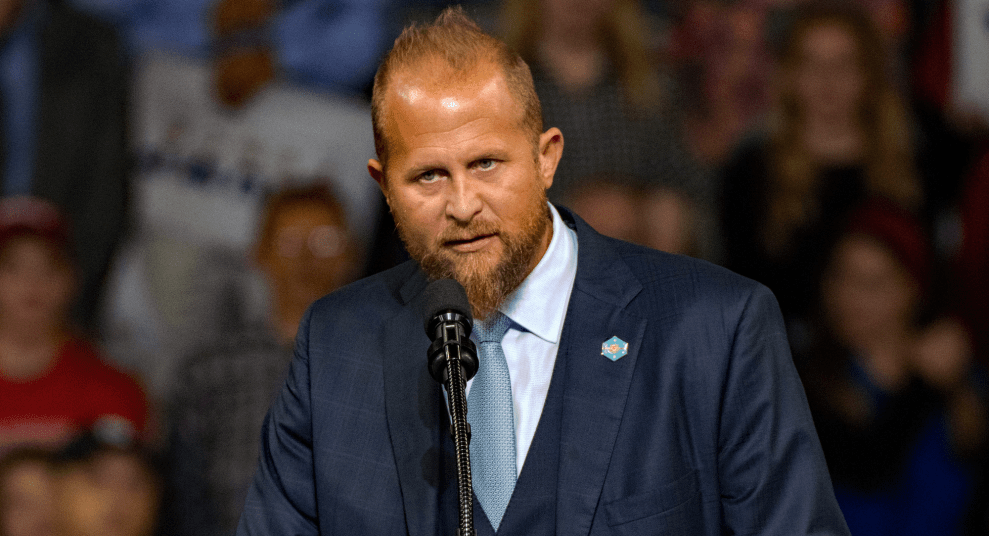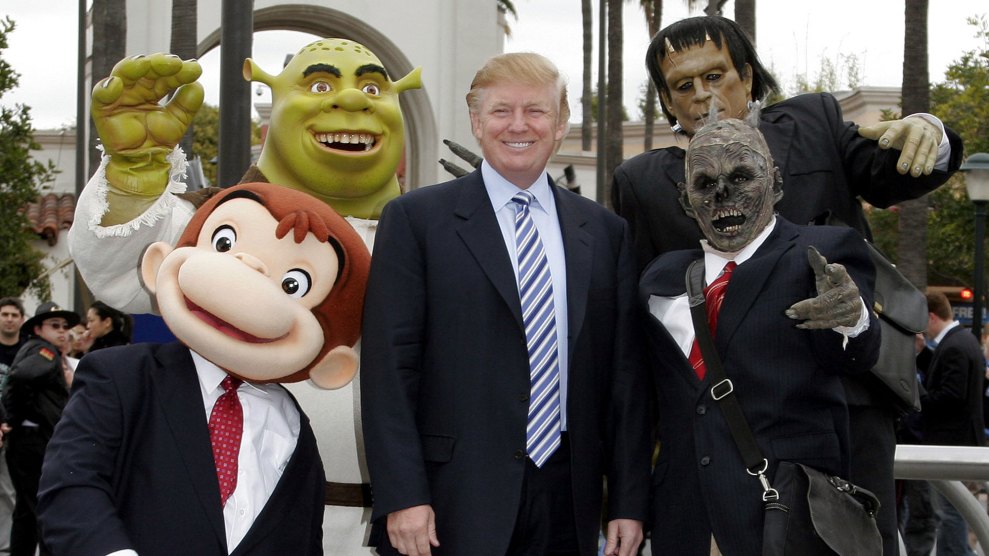
Mother Jones illustration; Getty
On a Friday evening in early October, more than 200 young African American conservatives in dark suits and red MAGA hats marched across Lafayette Square chanting, “USA! USA!” Their destination: The White House, where President Donald Trump was the featured guest at a reception for the pro-Trump student group Turning Point USA, which was hosting its annual black leadership summit in Washington.
Military musicians serenaded the attendees as they filed in under the massive crystal chandeliers of the historic East Room, where they were eventually joined by presidential adviser and Trump’s son-in-law Jared Kushner and Vice President Mike Pence. When Trump entered the room, the crowd again erupted in cheers of “USA! USA!” Teleprompters around the room showed that the president had a prepared speech about the ways his administration has benefited African Americans. Instead, the event quickly turned into what every Trump appearance seems to be: a campaign rally.
Straying far from his prepared remarks, Trump spoke for more than 40 minutes, taking the opportunity to promote his own greatness and blast away at his usual enemies: “Democrat lawmakers, their deep-state cronies, the fake news media.” For the past three years, he said, “They’ve been colluding in their effort to overturn the presidential election—63 million people voted—and to nullify the votes of the American people. And many African American people voted for Trump even then. Now they like me more, because I said I was going to do it and now I did it. So, you better vote.” The crowd went wild with applause and broke into a chant: “Four more years! Four more years!”
The event may have been standard fare for Trump, but it was anything but standard for the White House. As government property, the “people’s house” is supposed to be just that: a place for the American people regardless of party or voting record. It’s most definitely not supposed to host campaign rallies, and officially it doesn’t. But since taking office, Trump has blithely turned the White House into just another venue for his constant reelection campaign.
“This use of official positions to influence elections is permeating the entire government,” says Richard Painter, who served as the chief White House ethics lawyer during the administration of President George W. Bush. Since Trump took office, he says, “There’s no separation of the official work of the government from politics.” The White House did not respond to a request for comment, nor did the Trump reelection campaign.
Trump has used the White House to host receptions for campaign supporters; give Medals of Freedom to major donors or people who’ve endorsed him; and curry favor with pro-Trump media outlets. The black leadership summit was no exception. It was organized by Turning Point USA, a nonprofit pro-Trump student group with an annual budget of more than $10 million, funded by the oil and gas industry and big GOP donors, including conservative financier Foster Friess. Founder and director Charlie Kirk did youth outreach for the Trump campaign in 2016 and is tight with the president’s son, Donald Trump Jr., whose book tour TPUSA is currently sponsoring. The black leadership summit reception is the second time Trump has hosted the group since being elected.

Attendees listen to President Trump at the 2018 Young Black Leadership Summit at the White House.
Chris Kleponis / CNP via Zuma
After the White House reception, Kirk tweeted a photo of himself with Benny Johnson, TPUSA’s chief creative officer, and conservative comedian Terrence K. Williams, captioned, “The committee to re-elect President Trump.”
The committee to re-elect President Trump. pic.twitter.com/9UvLvtr8Kg
— Charlie Kirk (@charliekirk11) October 5, 2019
Even an ostensibly nonpartisan event like a Hispanic Heritage Month reception at the White House has, in the Trump years, become another opportunity for the president to bask in the glow of his adoring fans and urge them to get out and vote for him. In September, the Trump White House hosted its third Hispanic Heritage Month celebration since he became president.
Usually such events highlight high-level Latino members of an administration, but there are no high-profile Latino members of the Trump administration. The first—and only—such Cabinet member was Labor Secretary Alex Acosta, who was forced to resign in July after criticism for his role as the Florida US attorney who approved a sweetheart plea deal for the late billionaire pedophile Jeffrey Epstein. As a result, featured guests for the Hispanic Heritage Month event included Jovita Carranza, treasurer of the US who’s been nominated to run the Small Business Administration, Vice President Mike Pence, EPA administrator Andrew Wheeler (a white guy whose presence at the event seemed like a mistake), and a Latino border patrol agent.
As with the black leadership summit, this event kicked off with Trump’s adoring fans in the audience cheering, “Four more years! Four more years!” Trump autographed MAGA 2020 hats for guests and glad-handed with the crowd. When he went on a tirade against Democrats for obstructing his immigration policy, people in the audience cried, “They’re not patriots! They hate America!” The event was short on the bipartisanship most presidents strive for inside the official residence. Instead, the crowd was peppered with people who are part of the Trump campaign’s Latino outreach effort, including Florida’s Lt. Governor Jeanette Nunez, who is the co-chair of the campaign’s Latino advisory committee.
And what a better way to close out such an exciting Hispanic Heritage Month than the White House celebration, earlier this month. Thank you President Trump for acknowledging Latino contributions throughout this nation’s history. The American Dream is alive and well! pic.twitter.com/SicQNkpH7X
— Jeanette M. Nunez (@LtGovNunez) October 15, 2019
Joining Nunez were Bianca Gracia and Matthew Gomez, Texas conservative activists who, back in 2016, were among the original founders of the unofficial grassroots group Latinos for Trump. (Gomez now advises the campaign.) David Basulto, the Latino conservative who co-founded the “Lexit” movement to encourage Latinos to leave the Democratic Party was there. Singer Joy Villa, a member of the Trump campaign advisory board who wore a “build the wall” dress and a MAGA purse to the Grammys this year, made a return appearance to the event, which she has attended before, and posed for a glamour shot under a portrait of Bill Clinton. Perhaps the most unusual guest at the event was Paloma Zuniga, a Mexican American social media “influencer” whose Twitter handle is “Paloma for Trump.” Just days before, she was filmed chasing down migrants crossing the US border into Arizona and shoving a young child holding his father’s hand. The video went viral.
Mexican-born Paloma Zuniga who has dual citizenship in U.S. and Mexico yells at people who just crossed the Colorado River into the U.S from Mexico near Yuma, AZ. #Immigration #border #AZpatriots pic.twitter.com/L2lQTzDlcb
— Jack Gruber (@guygruber) September 24, 2019
Even those events nominally advertised as policy related have been not-so-thinly veiled efforts to rally the campaign’s foot soldiers. Consider the “Presidential Social Media Summit” in July, which was supposed to “bring together digital leaders for a robust conversation on the opportunities and challenges of today’s online environment.” It was billed as a serious discussion about free speech and regulation of big tech platforms such as Twitter and Facebook, except that no one from any of those big tech companies had been invited.
Also absent were policy experts or academics, unless you count former Trump adviser and current Salem Radio Network host Sebastian Gorka. (Gorka, who still refers to Trump as “the boss,” made headlines at the event when he challenged a Playboy reporter to a fight in the Rose Garden.) TPUSA’s Charlie Kirk was also there, along with Diamond and Silk, the African American social media personalities who are a frequent warmup act at Trump campaign rallies. Some of Trump’s congressional loyalists, Rep. Matt Gaetz (R-Fla.) and Sen. Marsha Blackburn (R-Tenn.), were also on hand. But while plenty of Democrats in Congress have been critics of big tech, the White House doesn’t seem to have invited any of them.
Dan Scavino, the White House social media director who served in the same role for Trump’s 2016 campaign, made an appearance along with many of the people who were major players in what became known as the Great Meme War of 2016. These folks, people like Carpe Donktum, who flooded social media with pro-Trump memes during the campaign, are often considered one of the secrets to Trump’s unlikely presidential victory. The social media event was clearly designed to keep the Trump meme army engaged in the 2020 campaign. “I think the White House social media summit is an opportunity to say thank you for the community that has been at the president’s side these last three years and enlist their help in the fights to come,” Eric Wilson, a Republican digital strategist, told the New York Times.
Trump told the social media influencers assembled in the White House’s storied East Room, “This is the most important election of our times.” He went on at length about the crowd size at his recent campaign kickoff rally, which had taken place a few weeks earlier in Orlando. “I think that we’re going to have a tremendous success,” he said, before mocking his leading opponent, former Vice President Joe Biden, for not drawing crowds of similar size. Trump lamented that he’d started calling Elizabeth Warren “Pocahantas” too soon in the election cycle. “I should’ve saved it,” Trump said in a rare moment of self-reflection.
As with so many of the norms that Trump has blasted through as president, it turns out there aren’t many official rules governing how presidents can use the White House. But traditionally, presidents of both parties tried to respect the dignity of the building and its place in public life by restricting its political uses to promoting policy initiatives. There have been some egregious exceptions, most notably President Bill Clinton, who famously rented out the Lincoln Bedroom to big donors and hosted White House coffees to raise money for his campaign. But neither his successor—George W. Bush—nor Barack Obama ever used the building for blatantly political spectacles.
Richard Painter says it’s not unusual for a president to have supporters attend events at the White House. But in the past, White House lawyers never would have allowed people to wear campaign hats or cheer “four more years” inside the White House, much less have the president hold forth about his reelection campaign. “A White House function cannot be a partisan event,” he says; they have to be policy-based. “It might be slanted in the sense that all the people are supporters and agree with what you’re doing on a policy basis, but you can’t have campaign regalia in there.”
While there aren’t any rules that constrain what the president or vice president can do in the White House, Painter says White House staff is barred by the Hatch Act from participating in campaign activities on government time and in government buildings. If any of them were involved in setting up the events for Hispanic Heritage Month or the black leadership summit, he says, they may have crossed a line.
“It’s improper to stick taxpayers with the bill for political events, which is why they don’t allow campaign events in government buildings,” says Sheila Krumholz, executive director of the Center for Responsive Politics, a nonprofit that tracks political spending and ethics. “But will it be challenged? I’m doubtful given the lengthy list of norms that [Trump has] upended.”
Part of the problem is that the Trump administration has decided to simply ignore the Hatch Act, as seen with White House counselor Kellyanne Conway, a repeat offender. The Office of Special Counsel, the independent federal watchdog that investigates Hatch Act violations, recommended this summer that Conway be fired because of her repeated public promotion of Trump’s reelection campaign from her official government post. But the special counsel can’t fire her; only Trump can, and he has said he won’t. Without any enforcement mechanism, Trump is free to promote his campaign from the White House without consequences, a distinct advantage over his Democratic opponents.
“Having an event at the White House is priceless to any party or campaign,” says Krumholtz. In theory, she says, if a campaign has an event inside a government building, it’s supposed to reimburse the federal government for it. “But with Trump, it seems nearly every pronouncement he makes or tweets is politicized, so it’s very hard to discern when he should be reimbursing for [White House] events he’s involved in. We’re in unorthodox times.”











